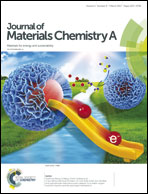Template synthesis of CoSe2/Co3Se4 nanotubes: tuning of their crystal structures for photovoltaics and hydrogen evolution in alkaline medium†
Abstract
Tubular-structured nanomaterials with tailorable crystal structures and shell architectures whose properties can be tuned without changing their chemical compositions are attractive in electrochemical energy conversion and storage fields. Herein, we report the fabrication of tubular-structured orthorhombic CoSe2 (o-CoSe2) and cubic CoSe2 (c-CoSe2) by calcining monoclinic Co3Se4 nanotubes (Co3Se4 NTs) prepared by a facile precursor transformation method. Benefiting from advantageous structural features, including functional shells and well-defined interior voids, the tubular-structured o-CoSe2 showed a high power conversion efficiency of 9.34% as a counter electrode catalyst for dye-sensitized solar cells (DSSCs), superior to that of a Pt counter electrode (8.15%), under AM 1.5 G irradiation. In addition, the o-CoSe2 nanotubes also demonstrated excellent electrocatalytic activity in terms of low onset overpotential (∼54 mV) and small Tafel slope (∼65.9 mV per decade) as a hydrogen evolution reaction (HER) catalyst in alkaline medium. Hence, this work provides a promising strategy to selectively design and synthesize highly active electrocatalysts for energy conversion.

- This article is part of the themed collection: JMC A Editor’s choice collection: Recent advances in photovoltaics


 Please wait while we load your content...
Please wait while we load your content...